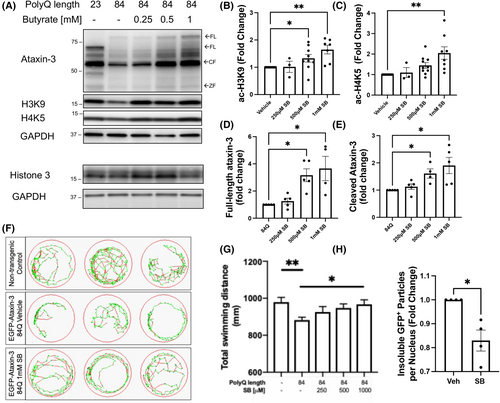
Sodium butyrate treatment increases histone acetylation and rescues the motor phenotype in SCA3 zebrafish. Zebrafish expressing ataxin-3 84Q were treated with 250 μM, 500 μM, or 1 mM sodium butyrate (SB), or vehicle control, between 1 and 6 days post fertilization (dpf). (A) Protein lysates of the 6 dpf zebrafish treated either SB or the vehicle control underwent western blotting and checked for ataxin-3, acetylated histone 3 at lysine 9 (ac-H3K9), and acetylated histone 4 at lysine 5 (ac-H4K5). Histone 3 was probed as a control. (B) Quantification of ac-H3K9 revealed a dose-dependent increase following SB treatment (500 μM, p = .0481; 1 mM, p = .0014, n = 3–9), while (C) quantification of ac-H4K5 revealed 1 mM SB was able to increase histone acetylation compared to the vehicle control (p = .0018, n = 3–10). (D) Quantification of full-length (FL) ataxin-3 revealed an increase with 500 μM and 1 mM SB (p = .039 and p = .0452, respectively, n = 4–5) while (E) levels of the cleavage fragment of ataxin-3 (CF) also demonstrated an increase with 500 μM and 1 mM SB treatment (p = .0452 and p = .0109, respectively, n = 4–5). (F) Swimming trajectories of 6 dpf zebrafish after treatment with vehicle versus 1 mM SB treatment (Green, slow movement; red, fast movement). (G) Motor behavior analysis showed vehicle-treated ataxin-3-84Q zebrafish swam shorter distances compared to the non-transgenic controls (p = .0085) while 6 dpf ataxin-3-84Q larvae treated with 1 mM SB ameliorated the motor dysfunction (p = .0393, n = 64–158). (H) Flow cytometric analysis of the insoluble GFP+ particles revealed a decrease with SB treatment compared with vehicle (p = .03, n = 4 group replicates). Data represent mean ± SEM. Statistical analysis was performed by a non-parametric one-way ANOVA (Kruskal Wallis) test and comparison between vehicle versus SB was analyzed using an unpaired student t-test. *p < 0.05, **p < 0.01.
|

